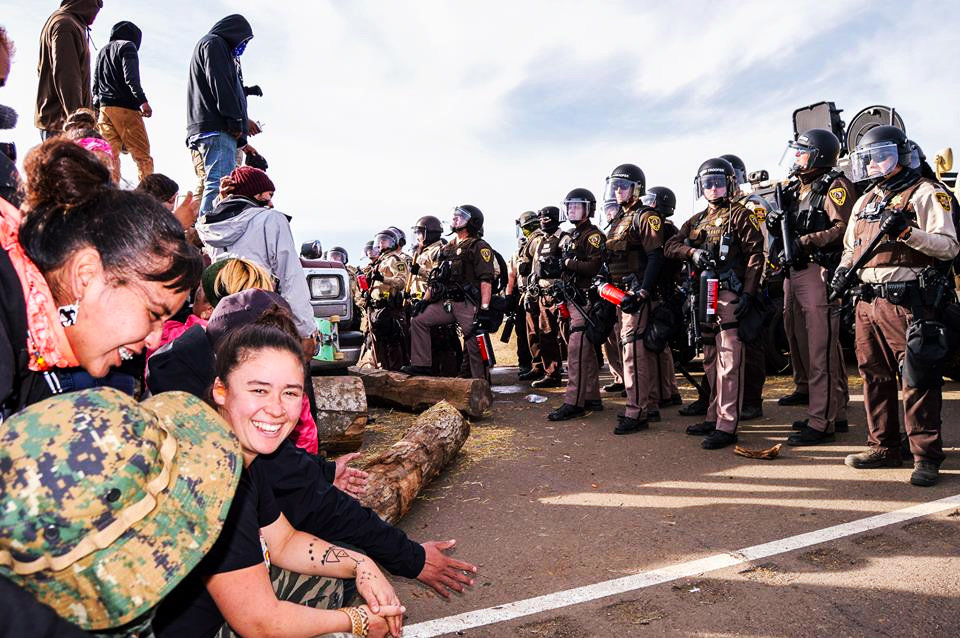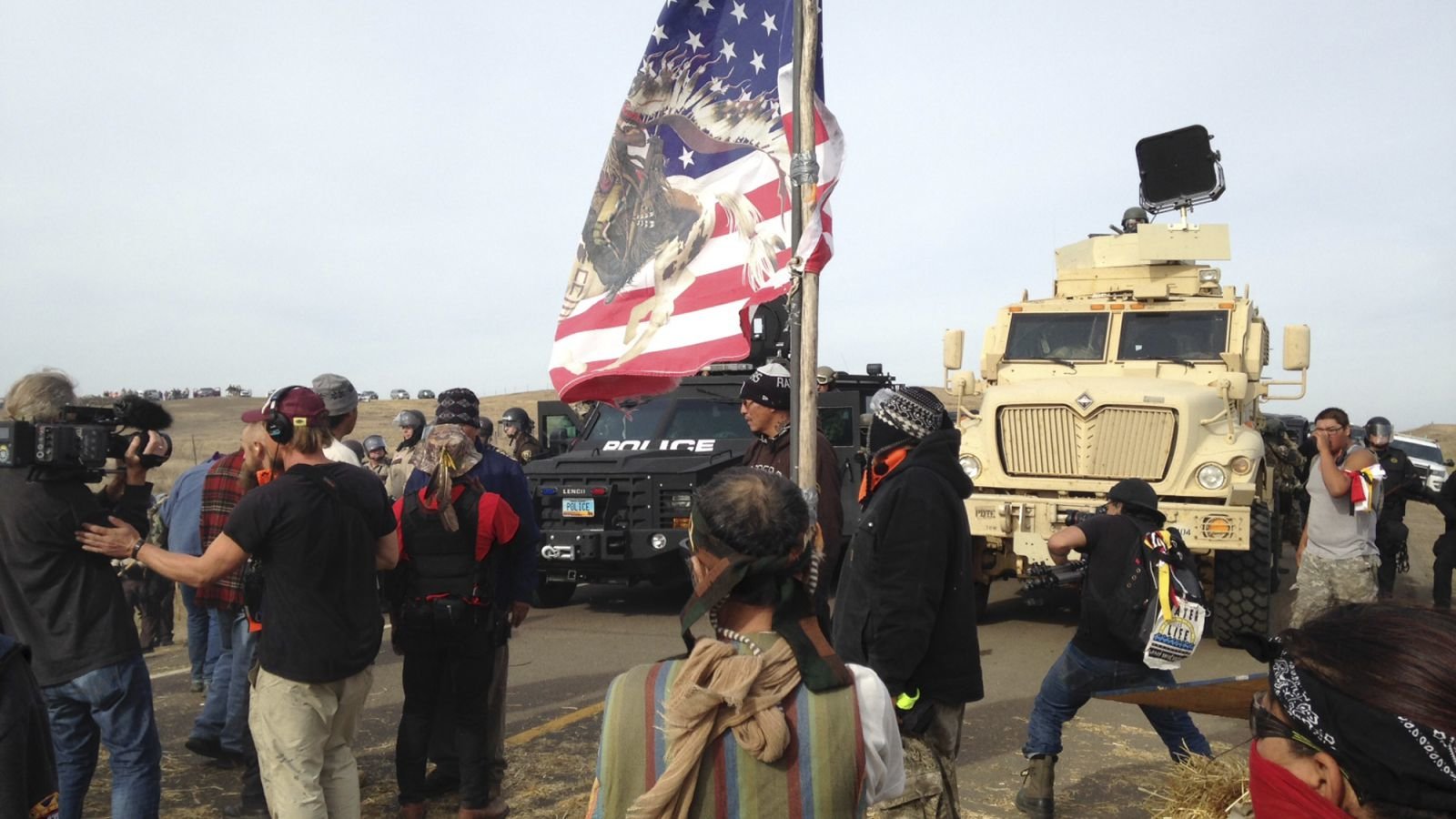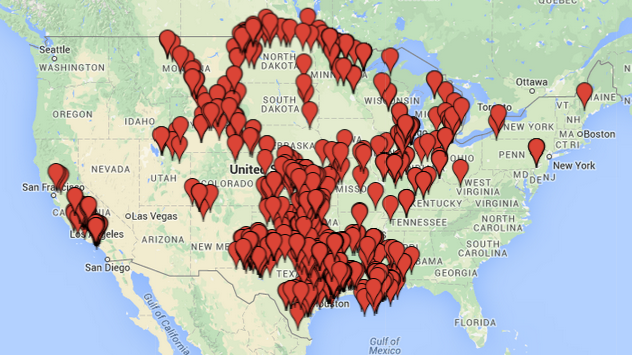There have been at least 2 reports of police officers turning in their badges acknowledging that this battle is not what they signed up for. You can see it in some of them, that they do not support the police actions. We must keep reminding them they are welcome to put down their weapons and badge and take a stand against this pipeline as well.The actions taken against the protesters have been completely out of proportion and demonstrate how little tolerance the state has for anyone who threatens the profit margins of the mighty corporations.
Some are waking up.
-Redhawk
LRADs (or Long-Range Acoustic Devices) are being employed in an attempt to disperse water-protectors. Violent mass-arrests and other punishment including strip-searches and being housed in dog kennels demonstrate that the rights of American citizens are being thrown out the window as the state becomes a corporate enforcer. One reporter was shot with a rubber bullet while interviewing a water protector. Her transgression? Having a camera.
What possible reason could there be for shooting this woman? Punishment, inspiring fear, threatening and executing violence against citizens who refuse to tolerate the corporate push to create yet another environmentally dangerous, highly profitable oil pipeline. The behavior of the police bears more resemblance to terrorism than that of the protestors.
Thankfully, or unfortunately, the state is burning through emergency funding in order to pay for this militarized police response.
Officers from at least 6 states have been deployed to North Dakota to fight for the companies behind the DAPL. Under the EMAC, North Dakota is responsible for reimbursing out-of-state police agencies for various costs such as wages, overtime, officer benefits, meals while officers are on duty, a per diem while officers are off duty, lodging and mileage for the communities that sent vehicles.Ten million dollars just to squash some hippies and natives? Seems pricey until you remember that the taxpayer, not the corporations behind DAPL, is footing the bill.
The state's Emergency Commission, headed by Gov. Jack Dalrymple, will vote Tuesday on whether to borrow $4 million from the state-owned bank.
The panel already borrowed and spent $6 million in September.
Obama has even weighed in, claiming that the Army Corps of Engineers is looking into rerouting the pipeline:
"As a general rule, my view is that there is a way for us to accommodate sacred lands of Native Americans, and I think that right now the Army Corps is examining whether there are ways to reroute this pipeline," Obama said Tuesday in an interview the social media start-up NowThis News, referring to the U.S. Army Corps of Engineers, which oversees the permitting process for the pipeline.Of course, this could all be posturing. Obama is leaving office in a couple months and then it will be someone else's problem. Killary weighed in after a group of protesters stormed her offices in Brooklyn, but the actual response was so tepid that it seemingly supports the pipeline companies:
"So we're going to let it play out for several more weeks and determine whether or not this can be resolved in a way that I think is properly attentive to the traditions of the first Americans," he said.
We received a letter today from representatives of the tribes protesting the construction of the Dakota Access Pipeline. From the beginning of this campaign, Secretary Clinton has been clear that she thinks all voices should be heard and all views considered in federal infrastructure projects. Now, all of the parties involved—including the federal government, the pipeline company and contractors, the state of North Dakota, and the tribes—need to find a path forward that serves the broadest public interest. As that happens, it's important that on the ground in North Dakota, everyone respects demonstrators' rights to protest peacefully, and workers' rights to do their jobs safely.See what she did there? Broadest public interest is politispeak for profits. It's just how these people think. The corporations and their board members probably hold some sanctimonious ideology like they're "bringing heat and power to Americans and doing such an awesome job!"
The jab at the end was also squarely aimed at the water-protectors. As if they're a violent and dangerous bunch who are using military grade equipment, attack dogs, chemical weapons and the authority to arrest and detain people in order to stop construction... In reality, it's the exact opposite, making it extremely odd that she makes no mention of the violence inflicted upon the protesters or that she stands in solidarity with them (obviously she does not).
Perhaps some people are wondering why folks are up in arms. After all, it's just another pipeline and we already have so many across the U.S. To answer that question, I suggest you check out this map that shows the number of incidents related to pipelines rupturing or leaking.
Not only do these leaks cause untold environmental damage, they also result in deaths. Keep in mind, this is only going back 6 years:
Industry insists that pipelines are safe, but ruptures and leaks are a daily occurrence. Eighty people have died and 389 have been injured in such incidents in the last five years.Going on two months now, these protests show no signs of letting up or going away. It will be interesting to follow the developments as they continue. For now if you want to support the water protectors there are many ways. You can check in remotely in a show of solidarity, or sign the White House petition that urges a halt to construction. With a bit of googling you can get creative, call your representatives in Congress, donate to their legal defense fund or just comment, tweet and post to show your support.
Since 2010, over 3,300 incidents of crude oil and liquefied natural gas leaks or ruptures have occurred on U.S. pipelines. These incidents have killed 80 people, injured 389 more, and cost $2.8 billion in damages. They also released toxic, polluting chemicals in local soil, waterways, and air.
According to the Pipeline and Hazardous Materials Safety Administration, these spills and ruptures released over 7 million gallons of crude. Individual leaks ranged from a few gallons to hundreds of thousands of gallons. One of the largest spills happened in North Dakota in 2013 when lightning struck a pipeline, which leaked over 840,000 gallons of crude onto a wheat field.
If we want things to change, we have to all be willing to make that change our responsibility in whatever ways we can.






Reader Comments
to our Newsletter